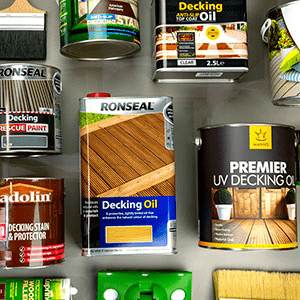Skirting Board Finish FAQ's
What is the best paint for skirting boards?
Picking the best paint for skirting boards is dependent on the type of finish required. For example, some prefer a classic high gloss white whilst others may prefer an eggshell finish. Skirting boards can also be painted in different colours and for some, using a low VOC eco-friendly paint is what they require. See our full range of skirting board paint products to find the one for your project.
What can I use to seal wooden skirting boards?
Wooden skirting boards have traditionally been sealed with a wood paint or wood varnish such as Manns Extra Tough Interior Varnish to protect against knocks, scuffs, dust and dirt. An alternative to using a wood paint or varnish is to use a wood oil. Wood oils provide excellent protection whilst enhancing the natural wood grain and character of the wood. Wood oils such as Osmo Polyx Oil are quick and easy to apply and are very easy to patch repair if an area of skirtingboard becomes worn, scuffed or lightly scratched.
I have new pine skirting that I want to protect without changing the colour. What can I use?
When using a clear varnish or wood oil they tend to darken the wood slightly giving it a 'damp-like' appearance. They also draw out the natural character and colouration of the timber. In the case of pine, this can often lead to a yellowy, orangey or warm brown coloration. Using a clear wax such as Fiddes Supreme Wax Polish in light / clear offers a solution but only limited protection against scuffs and knocks. The benefit of using a wax is that any lightly damaged or worn areas can be easily restored by simply applying more clear wax to the affected area.
An alternative would be to use Osmo Polyx Oil Raw (3044) or Fiddes Hard Wax Oil Natural. These wood oils are extremely durable and offer excellent protection against knocks, scuffs dust and dirt. They are specifically formulated to better retain the natural, untreated appearance of the wood and are easy to clean and maintain.
How can I stain wooden skirting boards to a darker colour?
New, bare wood skirting boards, or boards that have recently been stripped back to bare wood, can be easily stained using a wood stain or a coloured varnish. Use a water-based stain such as Manns Classic Pine Stain for softwood skirting boards such as pine or Manns Classic Oak Stain for hardwood skirting boards such as oak. Alternatively, use a solvent-based stain such as Manns Trade Light Fast Wood Stain or Morrells Light Fast Wood Stain if preferred. Stain the boards first then seal in the colour with a clear wood oil or an varnish which tend to 'brighten' the look of the stain. Alternatively, use a coloured wood oil such as Osmo Polyx Oil Tints or Fiddes Hard Wax Oil Tints.
Can you recommend a paint stripper for skirting boards?
Barrettine Paint Panther Paint and Varnish Remover has been a popular choice with our customers and is effective at removing a wide range of interior paints and varnishes from skirting boards and other interior wood.
An alternative product is PeelAway. Peelaway is a poultice or paste based paint stripper and varnish remover that is effective at removing many layers of paint or varnish, in one treatment. We recommend trying the PeelAway 1 and 7 Sample Twin Pack first to establish which product works best on the paint or varnish to be removed.
Advice needed on how to fill gaps between skirting boards and floorboards?
Filling the gaps between skirting boards and floor boards can be done using Bona Gap Master or Osmo Interior Gap Sealer. Both of these wood fillers are flexible and can be sanded smooth once fully dry, making them a better option than mastic based bathroom and kitchen sealers. These products are also available in a range of colours to better blend in with walls and flooring.
Hi, made a huge mistake I have primed, undercoated and glossed (satinwood) my house, so skirting door lining, architrave, stairs etc. The problem is it’s all pine and I didn’t apply a knot blocker so the knots have now bled through. Can I apply a knot blocker to the wood now and then apply a coat or two of satinwood to fix or do I need to strip the paint off and start again, which I really don't want to do!! Thanks.
Unfortunately, a knot blocker would need to be applied before the paint. It blocks naturally-forming resins found in wood from being dissolved by the solvents in paints and seeping to the surface. This then discolours the paint finish.
Ultimately, you would need to take back to bare wood to apply the knotting solution. This will allow the solution to soak into the knotted area effectively and prevent the resins from being expelled.
Rather than sanding back everything, it may be possible to sand back just the areas where the knots have bled through. Sand these areas thoroughly all the way back to bare wood, apply the knot blocker and allow to fully dry, re-apply the primer to the sanded areas and when dry, re-paint and blend in with the non-sanded areas. The issue with this approach is that there may still be knots that have not yet bled through which may still do at a later date. It is possible however that this might not happen.
Related blog posts
Disclaimer: Whilst every attempt has been made to provide product information that is as accurate as possible, it's important to clarify that trees and the wood that they produce can be affected by many factors. For example, the same species of tree grown in the same wood, even in close proximity, will be affected by age along with the amount of sunlight and water they receive. Other naturally occurring biological and environmental factors will also influence the density and grain of the wood as well as the moisture and oil content of the timber. No two trees are the same, meaning each piece of wood has the potential to look and react differently to the same wood finish. For example, product adhesion, colour variations, absorption rates and sheen levels. It is for this reason that we always strongly recommend carrying out test areas before starting any project


